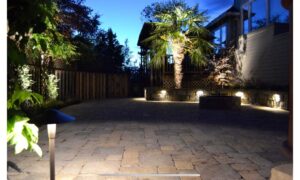Introduction:
In the realm of outdoor aesthetics and environmental design, the term “landscape” encompasses a myriad of elements that come together to create a visually stunning and harmonious outdoor space. Understanding these elements is crucial for both landscaping enthusiasts and professionals alike. In this comprehensive guide, we will delve into the four fundamental components that make up the backbone of any captivating landscape. From natural features to human interventions, let’s explore the intricate tapestry that transforms an ordinary outdoor space into a breathtaking panorama.
Four Essential Elements of a Landscape
1. Terrain and topography:
The foundation of any landscape is laid upon the natural contours and features of the terrain. Understanding the topography is essential for creating a harmonious design that complements the existing landforms. Hills, valleys, slopes, and water bodies are integral aspects that influence the layout and overall aesthetic of a landscape.
a. Hills and valleys:
Elevations play a pivotal role in determining the character of a landscape. Hills offer opportunities for panoramic views, while valleys can create intimate and sheltered spaces. Strategic placement of plants, pathways, and focal points can enhance the beauty of these natural features, adding depth and dimension to the overall design.
b. Slopes:
Sloped terrain presents both challenges and opportunities. Proper landscaping techniques, such as terracing and retaining walls, can be employed to manage slopes effectively. Incorporating a variety of plants, ground covers, and hardscaping elements not only controls erosion but also transforms slopes into visually captivating elements within the landscape.
c. Water Bodies:
Lakes, rivers, ponds, and even small streams introduce dynamic elements to a landscape. The reflective quality of water adds visual interest, while aquatic plants and wildlife contribute to biodiversity. The sound of running water can create a serene atmosphere, enhancing the overall sensory experience of the outdoor space.
2. Vegetation and Plant Life:
Plants are the heart and soul of any landscape, providing color, texture, and life. The strategic selection and arrangement of vegetation contribute to the overall aesthetic appeal, ecological balance, and functionality of the outdoor space.
a. Trees and shrubs:
Trees and shrubs offer vertical elements that define the skyline of a landscape. The choice of tree species can influence the scale, shade, and seasonal changes within the space. Shrubs, with their diverse forms and sizes, contribute to the layering effect and act as transition elements between various areas.
b. Flowers and Ground Covers:
The vibrant hues of flowers add a burst of color to the landscape, creating focal points and seasonal interest. Ground covers not only suppress weeds but also provide a unified and cohesive look to the ground. A thoughtful selection of plants based on climate, soil conditions, and maintenance requirements is crucial for a thriving landscape.
c. Lawns and Turf:
Lawns serve as open spaces for recreation and relaxation, offering a green carpet that contrasts with other elements in the landscape. Proper turf management, including irrigation, fertilization, and mowing, is essential to maintaining a lush and healthy lawn. Alternatives, such as meadows or ornamental grasses, can be considered for a more naturalistic approach.
3. Hardscaping Elements:
While natural elements dominate the landscape, hardscaping features add structure, functionality, and aesthetic diversity. These elements include pathways, walls, patios, and architectural structures that complement the organic aspects of the outdoor environment.
a. Pathways and Walkways:
Pathways guide movement through the landscape, creating a sense of flow and connectivity. The choice of materials, such as gravel, stone, or pavers, can influence the overall style and theme. Curved pathways can add intrigue and create a more naturalistic feel, while straight paths provide a formal and structured look.
b. Walls and Retaining Structures:
In terrains with varying elevations, retaining walls serve both functional and aesthetic purposes. They prevent soil erosion, create level planting areas, and add a vertical dimension to the landscape. The choice of materials, such as natural stone or concrete, can impact the visual character of the walls.
c. Patios and Outdoor Living Spaces:
Outdoor living spaces, including patios and decks, extend the functionality of a landscape, providing areas for dining, entertaining, and relaxation. The design of these spaces should harmonize with the overall theme, offering a seamless transition between indoor and outdoor living.
d. Sculptures and Art Installations:
Artistic elements, such as sculptures and installations, can serve as focal points or accents within the landscape. Thoughtfully placed artworks contribute to the overall aesthetic appeal and can evoke emotions or convey a theme.
4. Climate and microclimates:
Understanding the climatic conditions of a region is paramount to creating a resilient and sustainable landscape. Microclimates, which are small, localized climate variations within a larger area, further influence plant selection, water management, and overall design.
a. Plant Hardiness Zones:
Different regions have distinct plant hardiness zones based on temperature extremes. Choosing plants that are well-suited to the local climate ensures their survival and reduces the need for extensive maintenance. Native plants, adapted to the specific conditions of the area, are often a sustainable and low-maintenance choice.
b. Sun and Shade Patterns:
The orientation of a landscape and the presence of structures can create varying light conditions. Understanding sun and shade patterns is crucial for proper plant placement. Shade-loving plants can thrive in areas with limited sunlight, while sun-loving species are best suited to open, sunny spaces.
c. Wind and Rainfall:
Wind patterns and rainfall amounts contribute to the overall health and resilience of a landscape. Windbreaks, such as hedges or trees, can protect plants from strong winds, while appropriate drainage solutions prevent waterlogging. Rain gardens and sustainable water management practices contribute to water conservation and reduce runoff.
Conclusion:
A captivating landscape is a harmonious blend of natural and human-made elements. The intricate interplay between terrain, vegetation, hardscaping, and climate creates an outdoor environment that is not only visually stunning but also functional and sustainable. Whether you are a homeowner looking to enhance your backyard or a landscaping professional seeking inspiration, understanding these four essential elements will guide you in creating a landscape that stands the test of time, providing beauty and enjoyment for years to come. Embrace the artistry of landscaping, and let the transformative power of these elements unfold in your outdoor space.



































